| (48 intermediate revisions by 26 users not shown) | |||
| Line 1: | Line 1: | ||
| − | [[File:HumanGod.jpg|thumb|The Sha |
+ | [[File:HumanGod.jpg|thumb|The Sha Ka Ree Entity posing as the Christian God]] |
[[File:Jesus Christ.jpg|thumb|A depiction of Jesus Christ]] |
[[File:Jesus Christ.jpg|thumb|A depiction of Jesus Christ]] |
||
| − | [[File:SS Botany Bay-library.jpg|thumb| |
+ | [[File:SS Botany Bay-library.jpg|thumb|Books aboard the {{SS|Botany Bay}} included Christian works such as the '''Holy [[Bible]]''' (second from the right), ''[[Paradise Lost]]'' and ''[[Paradise Regained]]'' by [[John Milton|Milton]] and ''[[Dante's Inferno|Inferno]]'' by [[Dante]] ]] |
| − | '''Christianity''' was a [[Human]] [[religion]] based upon the teachings of [[Jesus Christ]] (Jesus of Nazareth), born from the [[Mary|Virgin Mary]]. The [[prophet]]s of the Old Testament and New Testament of the [[Bible]] like [[Methuselah]], [[Solomon]], [[Lazarus (Bible)|Lazarus]], and [[Saint Paul]] and many [[saint]]s like [[Saint Andrews|Saint Andrew]], [[Saint-Émilion|Saint Émilion]] and [[Saint Moritz]] also inspired the teaching of the Christian religion. |
+ | '''Christianity''' was a [[Human]] [[religion]] based upon the teachings of [[Jesus Christ]] (Jesus of Nazareth), born from the [[Mary|Virgin Mary]]. The [[prophet]]s of the Old Testament and New Testament of the [[Bible]] like [[Methuselah]], [[Solomon]], [[Lazarus (Bible)|Lazarus]], and [[Saint Paul]] and many [[saint]]s like [[Saint Andrews|Saint Andrew]], [[Saint-Émilion|Saint Émilion]], and [[Saint Moritz]] also inspired the teaching of the Christian religion. |
| ⚫ | Christianity was a monotheistic religion, stating that there was one God who created the universe. This one God, however, was both a unity and a trinity. There were three persons, God the Father, God the Son and God the Holy Spirit, who although distinct in person-hood share one and the same God-hood. Most images of the Christian God depicted a wise old man, seen as the universal [[father]] figure (indeed, God was often called "God the Father"), or Jesus Christ, who is God the Son incarnate as man, or the Holy Spirit with the image of a dove or as fire. In [[2287]], the [[God (Sha Ka Ree)|entity]] of [[Sha Ka Ree]] assumed this form of the Christian God so as to "better suit the expectations" of the USS ''Enterprise'' team who had encountered it. ({{film|5}}) |
||
| − | Christ was the main teacher of the Christian religion on the [[planet]] [[892-IV]] a group of [[Roman (892-IV)|Romans]] were mistakenly thought to be "[[sun]] worshipers" by the {{USS|Enterprise|NCC-1701}} [[landing party]] in [[2268]]. They were later corrected by [[Lieutenant]] [[Nyota Uhura|Uhura]], who, after monitoring [[Empire TV|Imperial broadcasts]], concluded the "sun" reference was intended to mean the "son" of [[God]]. Kirk thereafter assumed that the planet had shared both Imperial Rome and Jesus Christ with Earth. ({{TOS|Bread and Circuses}}) |
||
| ⚫ | |||
| ⚫ | Christianity was a monotheistic religion, stating that there was one |
||
| − | |||
| ⚫ | |||
Related belief systems included [[Judaism]] and the teachings of [[Plato]]. ({{TOS|Plato's Stepchildren}}) |
Related belief systems included [[Judaism]] and the teachings of [[Plato]]. ({{TOS|Plato's Stepchildren}}) |
||
| − | Christianity was one of the major religions on [[Earth]] and was the origin of several well |
+ | Christianity was one of the major religions on [[Earth]] and was the origin of several well-known beliefs such as the concept of [[Heaven]], [[Hell]], [[angel]]s, and the [[Devil]]. ({{TOS|The Cage|Who Mourns for Adonais?|Bread and Circuses|Day of the Dove}}) Christianity was a major religion in the [[21st century]] and its influences were still felt into the [[23rd century|23rd]] and [[24th century|24th centuries]] – most notably the use of Christian elements in [[wedding]]s and [[holiday]] celebrations like [[Christmas]]. ({{TOS|Dagger of the Mind|Balance of Terror}}; {{film|7}}; {{DS9|Penumbra}}) |
| − | In Christian beliefs, Hell was the underworld where the dead went, |
+ | In predominate Christian beliefs, Hell was the underworld where the dead went, to suffer eternally alongside (not under the rule of) the Devil and his demons. It was believed that people would be sent here after their death if they did not accept Jesus as savior and substitutionary sacrifice to atone for their sins against God. During his captivity on [[Talos IV]], Captain [[Christopher Pike]] was subjected to an illusion of Hell when he refused to cooperate with his [[Talosian]] jailers. ({{TOS|The Cage}}) |
| − | == Holy |
+ | == Holy writings == |
| − | The main |
+ | The main written work used by Christians was the [[Bible]]. The name of the [[Genesis Device]] was taken from the Christian Bible (the Book of Genesis) which described the beginnings of life on [[Earth]]. ({{film|2}}) A well-known precept from the Bible was "Love your neighbor." ({{VOY|Fair Haven}}) |
Parts of the Bible described the end of the world; however, Jean-Luc Picard seemed to indicate a strong distaste for apocalyptic traditions, first when discussing his personal beliefs about the [[afterlife]], ({{TNG|Where Silence Has Lease}}) and again when he was briefly taken by the [[Mintakan]]s to be their ancient god. ({{TNG|Who Watches The Watchers}}) |
Parts of the Bible described the end of the world; however, Jean-Luc Picard seemed to indicate a strong distaste for apocalyptic traditions, first when discussing his personal beliefs about the [[afterlife]], ({{TNG|Where Silence Has Lease}}) and again when he was briefly taken by the [[Mintakan]]s to be their ancient god. ({{TNG|Who Watches The Watchers}}) |
||
[[File:Preacher.jpg|thumb|A 20th century preacher]] |
[[File:Preacher.jpg|thumb|A 20th century preacher]] |
||
| − | + | In a [[vision]] sent to [[Benjamin Sisko]] by the [[Prophet]]s, his father [[Joseph Sisko]] took the role of a [[1950s]] [[Unnamed Humans (20th century)#the Preacher|preacher]]. Although Benjamin had never previously heard his father quote from the Bible, after he told his father about his experience the elder Sisko recited, "''I have fought the good fight. I have finished the course. I have kept the faith.''" ({{DS9|Far Beyond the Stars}}) |
|
| + | {{bginfo|This quotation comes from 2 Timothy 4:7.}} |
||
| − | In [[2370]], [[Beverly Crusher]] attended her grandmother [[Felisa Howard]]'s funeral on [[Caldos]]. The colony leader, [[Maturin]], performed traditional burial |
+ | In [[2370]], [[Beverly Crusher]] attended her grandmother [[Felisa Howard]]'s funeral on [[Caldos]]. The colony leader, [[Maturin]], performed traditional burial rites and used the expression "ashes to ashes and dust to dust." ({{TNG|Sub Rosa}}) |
| + | {{bginfo|This phrase is from the Anglican ''Book of Common Prayer'', which in turn has its roots in the Biblical verse of Genesis 3:19.}} |
||
| − | [[Flint]] possessed a Gutenberg Bible, a version of the Bible mass-produced during the [[15th century]] by [[ |
+ | [[Flint]] possessed a Gutenberg Bible, a version of the Bible mass-produced during the [[15th century]] by [[Johannes Gutenberg]], among his collection of extremely rare books. ({{TOS|Requiem for Methuselah}}) [[Berlinghoff Rasmussen]] compared being close to [[Data]] to examining a rare Gutenberg Bible. ({{TNG|A Matter of Time}}) |
[[Samuel T. Cogley]] had a Bible in his library in [[2267]]. ({{TOS|Court Martial}}) A copy of the Holy Bible was among the small collection of books found aboard the {{SS|Botany Bay}}. ({{film|2}}) |
[[Samuel T. Cogley]] had a Bible in his library in [[2267]]. ({{TOS|Court Martial}}) A copy of the Holy Bible was among the small collection of books found aboard the {{SS|Botany Bay}}. ({{film|2}}) |
||
| − | The ideas from the Bible were used in many sayings and written literature. Joseph Sisko often told Benjamin that "''the road to Hell is paved with good intentions.''" ({{DS9|In the Pale Moonlight}}) In the [[17th century]], [[John Milton]] of [[Earth]] wrote in his poem ''[[Paradise Lost]]'' that "''It is better to rule in [[Hell]] than serve in [[heaven]].''" ({{TOS|Space Seed |
+ | The ideas from the Bible were used in many sayings and written literature. Joseph Sisko often told Benjamin that "''the road to Hell is paved with good intentions.''" ({{DS9|In the Pale Moonlight}}) In the [[17th century]], [[John Milton]] of [[Earth]] wrote in his poem ''[[Paradise Lost]]'' that "''It is better to rule in [[Hell]] than serve in [[heaven]].''" ({{TOS|Space Seed}}) |
| − | + | An [[angel]] is a figure from Christian mythology described as a messenger of God. In a holographic simulation [[Lord Byron]] said to [[Gandhi]] that "It is said the angels themselves take pleasure in their bodies of light." ({{VOY|Darkling}}) In [[2267]], Dr. [[Leonard McCoy|McCoy]], expressing frustration at the restrictions of the [[Prime Directive]], joked that he would like to beam down to a primitive [[planet]] and say, "''Behold, I am the [[Gabriel (archangel)|Archangel Gabriel]]!''" ({{TOS|Bread and Circuses}}) In [[2375]], [[Jack (24th century)|Jack]] claimed that his laws of [[physics]]-bending machine "could clip the wings of an angel dancing on the head of a pin." ({{DS9|Chrysalis}}) |
|
== Holy places and rituals == |
== Holy places and rituals == |
||
[[File:Cross in chapel.jpg|thumb|A cross in the chapel]] |
[[File:Cross in chapel.jpg|thumb|A cross in the chapel]] |
||
| − | Christians practiced their religion in |
+ | Christians practiced their religion in [[church]]es and chapels. In the [[2150s]], [[Doctor|Dr.]] [[Phlox]] of the {{EnterpriseNX}} recalled attending a [[Mass]] at [[Saint Peter's Square]] in [[Rome]], the [[history|historic]] headquarters of Catholic Christianity. ({{ENT|Cold Front}}) A [[century]] later, at her [[wedding]], [[phaser]] [[specialist]] [[Angela Martine]] genuflected toward the altar of the ship's [[chapel]], ({{TOS|Balance of Terror}}) and another century later the [[hologram]] of [[Leonardo da Vinci]] asked [[Kathryn Janeway]] if she would like to [[prayer|pray]] with him in [[Santa Croce]] church. ({{VOY|Scorpion}}) |
{{bginfo|The wedding in {{e|Balance of Terror}} took place in a chapel with an altar. The chapel wall behind [[Captain]] [[James T. Kirk|Kirk]] had at least two symbols on it, one of them looking somewhat like a cross, a common symbol used by Christianity. The other is not associated with any known religion.}} |
{{bginfo|The wedding in {{e|Balance of Terror}} took place in a chapel with an altar. The chapel wall behind [[Captain]] [[James T. Kirk|Kirk]] had at least two symbols on it, one of them looking somewhat like a cross, a common symbol used by Christianity. The other is not associated with any known religion.}} |
||
| Line 47: | Line 47: | ||
In [[2376]], [[The Doctor]] portrayed a Catholic [[priest]] in [[Tom Paris]]'s ''[[Fair Haven]]'' [[holoprogram]], a simulation of a [[19th century]] [[Irish]] village. ({{VOY|Fair Haven}}) During an appearance to the crew of the {{USS|Enterprise|NCC-1701-D|-D}}, [[Q]] pretended he was a Franciscan [[monk]]. ({{TNG|Hide and Q}}) |
In [[2376]], [[The Doctor]] portrayed a Catholic [[priest]] in [[Tom Paris]]'s ''[[Fair Haven]]'' [[holoprogram]], a simulation of a [[19th century]] [[Irish]] village. ({{VOY|Fair Haven}}) During an appearance to the crew of the {{USS|Enterprise|NCC-1701-D|-D}}, [[Q]] pretended he was a Franciscan [[monk]]. ({{TNG|Hide and Q}}) |
||
| − | The Christian religion had many holidays; one called [[Christmas]] was experienced by Captain [[Jean-Luc Picard]] during his interrogation by [[Gul]] [[Madred]], and during his [[time]] spent in the [[Nexus]], his visions included one of a traditional [[Christmas tree]]. ({{TNG|Chain of Command, Part II}}; {{film|7}}) Before that, Christmas parties were celebrated on the {{USS|Enterprise|NCC-1701}}, ({{TOS|Dagger of the Mind}}) and another called [[Carnival]], a traditional celebration before the beginning of the Catholic season of Lent, |
+ | The Christian religion had many holidays; one called [[Christmas]] was experienced by Captain [[Jean-Luc Picard]] during his interrogation by [[Gul]] [[Madred]], and during his [[time]] spent in the [[Nexus]], his visions included one of a traditional [[Christmas tree]]. ({{TNG|Chain of Command, Part II}}; {{film|7}}) Before that, Christmas parties were celebrated on the {{USS|Enterprise|NCC-1701}}, ({{TOS|Dagger of the Mind}}) and another called [[Carnival]], a traditional celebration before the beginning of the Catholic season of Lent, still celebrated during the 24th century. ({{DS9|The Ship}}) |
| − | |||
| ⚫ | |||
| ⚫ | |||
| ⚫ | |||
| ⚫ | |||
| − | == Christianity in the 24th century == |
||
| − | There were still Christians in the 24th century; [[Kasidy Yates]] mentioned to Benjamin Sisko that her mother would prefer her to be married by a minister (a traditional title for a Christian cleric). ({{DS9|Penumbra}}) Kasidy Yates also was asked by her new husband, Benjamin Sisko, to help with a Bajoran blessing ceremony and she refused, saying that she married him, but didn't convert. ({{DS9|Strange Bedfellows}}) |
||
| + | ==Children of the Son== |
||
| − | {{bginfo|This contradicts [[Gene Roddenberry]]'s original concept of Earth religions being completely extinct by the time of ''Star Trek''.}} |
||
| + | In a remarkable example of [[Hodgkin's Law of Parallel Planetary Development]], a religion very similar to early Christianity emerged on the [[planet]] [[892-IV]], called the [[Children of the Son]]. They focused on the teachings of the [[Son]], which was analogous to Christ. ({{TOS|Bread and Circuses}}) |
||
== External links == |
== External links == |
||
| Line 63: | Line 61: | ||
[[de:Christentum]] |
[[de:Christentum]] |
||
| + | [[fr:Christianisme]] |
||
[[nl:Christendom]] |
[[nl:Christendom]] |
||
[[Category:Earth]] |
[[Category:Earth]] |
||
Revision as of 07:32, 8 September 2014
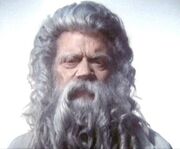
The Sha Ka Ree Entity posing as the Christian God
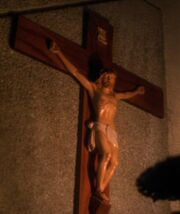
A depiction of Jesus Christ
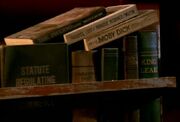
Books aboard the SS Botany Bay included Christian works such as the Holy Bible (second from the right), Paradise Lost and Paradise Regained by Milton and Inferno by Dante
Christianity was a Human religion based upon the teachings of Jesus Christ (Jesus of Nazareth), born from the Virgin Mary. The prophets of the Old Testament and New Testament of the Bible like Methuselah, Solomon, Lazarus, and Saint Paul and many saints like Saint Andrew, Saint Émilion, and Saint Moritz also inspired the teaching of the Christian religion.
Christianity was a monotheistic religion, stating that there was one God who created the universe. This one God, however, was both a unity and a trinity. There were three persons, God the Father, God the Son and God the Holy Spirit, who although distinct in person-hood share one and the same God-hood. Most images of the Christian God depicted a wise old man, seen as the universal father figure (indeed, God was often called "God the Father"), or Jesus Christ, who is God the Son incarnate as man, or the Holy Spirit with the image of a dove or as fire. In 2287, the entity of Sha Ka Ree assumed this form of the Christian God so as to "better suit the expectations" of the USS Enterprise team who had encountered it. (Star Trek V: The Final Frontier)
The Virgin Mary and Saint Anne were depicted in the Leonardo da Vinci painting The Virgin and Child with St. Anne, which was found among the relics in Kathryn Janeway's da Vinci holodeck program. (VOY: "Scorpion", "The Raven", "Scientific Method", "Concerning Flight")
Related belief systems included Judaism and the teachings of Plato. (TOS: "Plato's Stepchildren")
Christianity was one of the major religions on Earth and was the origin of several well-known beliefs such as the concept of Heaven, Hell, angels, and the Devil. (TOS: "The Cage", "Who Mourns for Adonais?", "Bread and Circuses", "Day of the Dove") Christianity was a major religion in the 21st century and its influences were still felt into the 23rd and 24th centuries – most notably the use of Christian elements in weddings and holiday celebrations like Christmas. (TOS: "Dagger of the Mind", "Balance of Terror"; Star Trek Generations; DS9: "Penumbra")
In predominate Christian beliefs, Hell was the underworld where the dead went, to suffer eternally alongside (not under the rule of) the Devil and his demons. It was believed that people would be sent here after their death if they did not accept Jesus as savior and substitutionary sacrifice to atone for their sins against God. During his captivity on Talos IV, Captain Christopher Pike was subjected to an illusion of Hell when he refused to cooperate with his Talosian jailers. (TOS: "The Cage")
Holy writings
The main written work used by Christians was the Bible. The name of the Genesis Device was taken from the Christian Bible (the Book of Genesis) which described the beginnings of life on Earth. (Star Trek II: The Wrath of Khan) A well-known precept from the Bible was "Love your neighbor." (VOY: "Fair Haven")
Parts of the Bible described the end of the world; however, Jean-Luc Picard seemed to indicate a strong distaste for apocalyptic traditions, first when discussing his personal beliefs about the afterlife, (TNG: "Where Silence Has Lease") and again when he was briefly taken by the Mintakans to be their ancient god. (TNG: "Who Watches The Watchers")
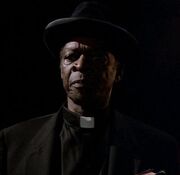
A 20th century preacher
In a vision sent to Benjamin Sisko by the Prophets, his father Joseph Sisko took the role of a 1950s preacher. Although Benjamin had never previously heard his father quote from the Bible, after he told his father about his experience the elder Sisko recited, "I have fought the good fight. I have finished the course. I have kept the faith." (DS9: "Far Beyond the Stars")
In 2370, Beverly Crusher attended her grandmother Felisa Howard's funeral on Caldos. The colony leader, Maturin, performed traditional burial rites and used the expression "ashes to ashes and dust to dust." (TNG: "Sub Rosa")
Flint possessed a Gutenberg Bible, a version of the Bible mass-produced during the 15th century by Johannes Gutenberg, among his collection of extremely rare books. (TOS: "Requiem for Methuselah") Berlinghoff Rasmussen compared being close to Data to examining a rare Gutenberg Bible. (TNG: "A Matter of Time")
Samuel T. Cogley had a Bible in his library in 2267. (TOS: "Court Martial") A copy of the Holy Bible was among the small collection of books found aboard the SS Botany Bay. (Star Trek II: The Wrath of Khan)
The ideas from the Bible were used in many sayings and written literature. Joseph Sisko often told Benjamin that "the road to Hell is paved with good intentions." (DS9: "In the Pale Moonlight") In the 17th century, John Milton of Earth wrote in his poem Paradise Lost that "It is better to rule in Hell than serve in heaven." (TOS: "Space Seed")
An angel is a figure from Christian mythology described as a messenger of God. In a holographic simulation Lord Byron said to Gandhi that "It is said the angels themselves take pleasure in their bodies of light." (VOY: "Darkling") In 2267, Dr. McCoy, expressing frustration at the restrictions of the Prime Directive, joked that he would like to beam down to a primitive planet and say, "Behold, I am the Archangel Gabriel!" (TOS: "Bread and Circuses") In 2375, Jack claimed that his laws of physics-bending machine "could clip the wings of an angel dancing on the head of a pin." (DS9: "Chrysalis")
Holy places and rituals
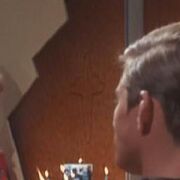
A cross in the chapel
Christians practiced their religion in churches and chapels. In the 2150s, Dr. Phlox of the Enterprise NX-01 recalled attending a Mass at Saint Peter's Square in Rome, the historic headquarters of Catholic Christianity. (ENT: "Cold Front") A century later, at her wedding, phaser specialist Angela Martine genuflected toward the altar of the ship's chapel, (TOS: "Balance of Terror") and another century later the hologram of Leonardo da Vinci asked Kathryn Janeway if she would like to pray with him in Santa Croce church. (VOY: "Scorpion")
During a trip back to the year 1930, James T. Kirk made reference to an American missionary living in China. (TOS: "The City on the Edge of Forever")
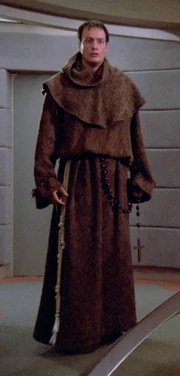
Q in a Franciscan monk's garb, wielding a cross
Christians sang and played music. Despite Montgomery Scott's disbelief in gods, he played a Christian hymn traditionally associated with Scottish funerals, Amazing Grace, on the bagpipes at Spock's funeral in 2285. (TOS: "Who Mourns for Adonais?"; Star Trek II: The Wrath of Khan)
In 2376, The Doctor portrayed a Catholic priest in Tom Paris's Fair Haven holoprogram, a simulation of a 19th century Irish village. (VOY: "Fair Haven") During an appearance to the crew of the USS Enterprise-D, Q pretended he was a Franciscan monk. (TNG: "Hide and Q")
The Christian religion had many holidays; one called Christmas was experienced by Captain Jean-Luc Picard during his interrogation by Gul Madred, and during his time spent in the Nexus, his visions included one of a traditional Christmas tree. (TNG: "Chain of Command, Part II"; Star Trek Generations) Before that, Christmas parties were celebrated on the USS Enterprise, (TOS: "Dagger of the Mind") and another called Carnival, a traditional celebration before the beginning of the Catholic season of Lent, still celebrated during the 24th century. (DS9: "The Ship")
When Jake Sisko ran into a wounded soldier on Ajilon Prime, the soldier asked that he made sure that he died with his eyes directed toward the sky. (DS9: "Nor the Battle to the Strong")
Children of the Son
In a remarkable example of Hodgkin's Law of Parallel Planetary Development, a religion very similar to early Christianity emerged on the planet 892-IV, called the Children of the Son. They focused on the teachings of the Son, which was analogous to Christ. (TOS: "Bread and Circuses")
External links
- Template:NCwiki
- Christianity at Wikipedia
